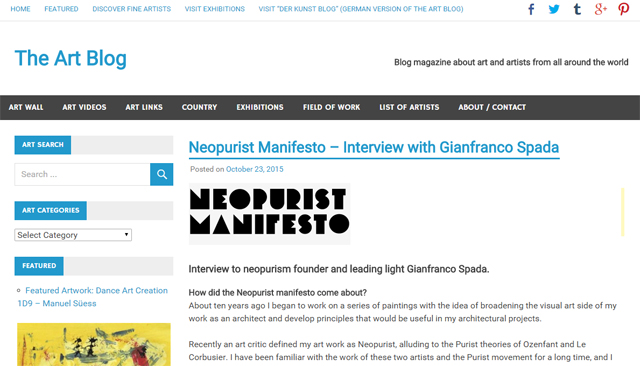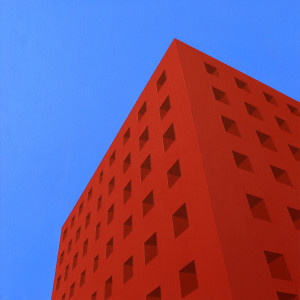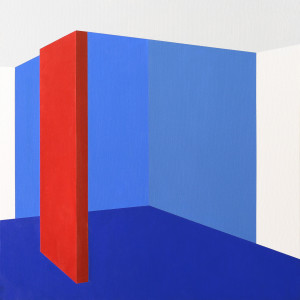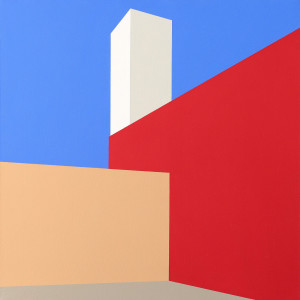
Published in: The Art Blog
By Luisa Arienti
– Source: http://the-art-blog.info/3161/neopurist-manifesto-interview-with-gianfranco-spada/
– Read in pdf format
Interview to neopurism founder and leading light Gianfranco Spada.
How did the Neopurist manifesto come about?
About ten years ago I began to work on a series of paintings with the idea of broadening the visual art side of my work as an architect and develop principles that would be useful in my architectural projects.
Recently an art critic defined my art work as Neopurist, alluding to the Purist theories of Ozenfant and Le Corbusier. I have been familiar with the work of these two artists and the Purist movement for a long time, and I had read about the movement, but I had never connected it to what I was doing. Rereading “Après le cubisme”, written in 1918 as the foundation text of the Purist movement, I realised how much common ground exists between that movement and what I am trying to do a hundred years later, but also the extent to which my work goes a step further. That is why I understand that I should be termed a “Neopurist”. While pondering the core principles of Neopurism, I thought of drawing up a manifesto.
Does Neopurism have Purism as its sole source, then?
No, though it is the main source, given that it is a sort of continuation of the original Purism; which is what I’d like the “neo” prefix to indicate. But I don’t overlook other movements such as California “hard-edge”, Sheeler’s “Precisionism” or the “concretism” of the Paris group Abstraction-Création, movements that have all drunk from the well of Purism to a greater or lesser extent.
The Purists, like other members of the avant-garde, were interested in machines, but I note that Neopurism appears to reject them. Why?
That’s correct. Though they didn’t show them in their paintings, Ozenfant and Le Corbusier were greatly impressed by machines, as something new that symbolized modernity. Neopurism, on the other hand, in an era in which everything is possible thanks to machines, which have become a sort of appendage or prosthesis of the human body, opts for the recovery of craftsmanship that distances itself from the machine-dominated view of the world and of art.
You state that pure art is born out of the need for order?
In a way, Purism is a reaction towards “order” in the face of the great chaos unleashed by the First World War. Neopurism is partly a reaction towards “order” given the chaos in which the world in general, and the art world in particular, have been living for several decades. In the face of this chaos, Neopurism presents a desire for formal order, as it sets out a series of elements which are clearly organized on the surface of the canvas: clear geometry, clean lines, flat colours; but with, shall we say, the addition of a spiritual dimension, because into a world of chaos objects are introduced that convey a sense of order and rationality.
Neopurists reject utilitarian art. What do you mean by this?
We Neopurists believe in an art without adjectives, one that does not have a function, be this social, political, promotional, commercial, functional, self-promoting, etc. Art is an end in itself rather than a propaganda vehicle or a public relations exercise. For example, we have seen how a well-known chef was invited to show his gastronomic creations in Documenta in 2007, one of the most important art fairs in the world: here, a practical object, a plate of food, has been raised to the status of a work of art. We have reached a situation of such absurdity that anything may be considered art, and people are outraged if what they make or do in the pursuit of originality isn’t considered art (a chef, a hairdresser…). This widespread misconception leads to the belief that anything unusual or original is in some way art, and so anyone capable of producing something unusual or original is an artist. Additionally, pure art rejects everything that can be better expressed by different means, there’s no need to burden art with things that have no place there. If you want to communicate something, write an article; if you want to change society, become a politician or a revolutionary. This is what Neopurism rejects.
What do you mean when you talk of art as a public relations exercise?
I’m referring to the use of art as a way of making a name for yourself and expressing your individuality at all costs. Art then becomes a mere publicity vehicle, a medium that puts itself at the disposal of a spurious cause. For example, those graffiti artists who obsessively repeat a visual motif, a slogan, a name everywhere they can in a kind of act of self-affirmation and onanistic self-satisfaction. These so-called artists use art to show us how fabulous, sensational, brilliant, insightful, etc. they are as individuals.
You seem to be opposed to the lax use of the word artist nowadays.
The great Ramón Gaya always differentiated between artists and creators. Nowadays we are surrounded by artists, but I don’t think there are that many creators. I almost dare to say that this is a time in which everyone, chefs, hairdressers, fashion or furniture designers and the like, is an artist, whereas in fact they are just good craftsmen.
Neopurism appears to reject improvisation. Why?
Because a work of pure art should be the rigorous expression of a rigorous concept. Any improvisation is the fruit of an individuality seeking to express itself, project itself, announce itself. I’m thinking, for example, of Jackson Pollock, whose abstract expressionism can only be understood as the result of a performance, a show, a mise-en-scène around the individuality of the artist. The end result is mere improvisation, chaotic and haphazard. These works of art are nothing more than pure abstract decoration, baroque, decorative camouflage which has nothing to do with pure art.
Why can’t art be figurative?
Because it doesn’t need to be. It doesn’t need to tell stories, or recount facts. In the words of Ozenfant and Le Corbusier: “Art is not a servant obliged to remind his master of the lesser and larger emotions he has experienced”.
How can we recognise a Neopurist work?
To begin with, a Neopurist work does not have to be the result of the deliberate application of Neopurist precepts. Neopurism is not a school as such; it is above all a filter that allows us to read a work of art. In this way, we can recognise Neopurist elements in the work of authors who have not followed these tenets. My work, for example, responds to these precepts in various ways. For instance, I use flat colours that I apply uniformly, without any mixing or transitions, in an impersonal manner. My canvases are square and not very big (60×60); square, so as to avoid the arbitrariness of form and orientation, as if to reduce the field of vision of the human eye, which tends to view in landscape mode, and hence oblige the viewer to perceive the canvas as a three-dimensional work of art; and not very big because I want the viewer to perceive all at once and in full the entirety of the work and be unable to engage in a piecemeal reading that might entail a narrative interpretation and a certain subjective perception . Another fundamental characteristic of Neopurism is geometric abstraction inspired in reality. In my case, this reality is mainly architectural; I borrow various well-known works, mainly by renowned architects, so that the spectator, whose visual memory makes these easy to recognise, is induced, erroneously, into perceiving something more than simple abstract smudges consisting of flat colours without texture, which is what I have really represented.
Is Neopurist abstraction, then, always based on reality?
Yes. Pure art, as the manifesto states, derives from physical reality, as otherwise it would be an ornamental arrangement of forms and colours. The work of Mondrian, for example, in his Neoplastic phase, despite having many elements that might be termed Neopurist, did not start from reality; despite his claims that it was an exploration of the absolute, it remains a merely decorative conjuncture of form and colour, which has ended up itself becoming trivialized as a visual cliché.
Finally, I am intrigued by the typeface you use in the manifesto. It reminds me of the avant-garde.
Yes, that’s understandable. That typeface, as well as being appropriate to the concept of Neopurism for its geometric feel, is really also a homage to some specific places in the city of Valencia – the city, of course, that saw the birth of Neopurism. It is the typeface that was used to identify the anti-aircraft shelters that were put up in the Civil War. Some can still be seen here and there, that is why it has a 1930s avant-garde feel. As such, it is a homage to these metaphors of resistance at a time when anything goes in a chaotic and wild art world.
www.neopurismo.info
—
Artwork Copyright
Artist: Gianfranco Spada
Photographer: Marco Sacchi
Interviewer: Luisa Arienti
*********************
Neopurist Manifesto
Pure art arises out of a need for ordening.
A work of pure art must provoke an emotion of geometric order.
The haphazard is the opposite of pure art.
Pure art answers only to the laws of art.
A work of pure art is the rigorous expression of a rigorous concept.
A work of pure art should be perceived as a whole and not piecemeal.
Pure art is not figurative.
Pure art is not narrative: it does not need to tell stories nor present facts.
Pure art eschews the strange and the original.
Pure art is not utilitarian: it is not decoration, propaganda, protest or self-promotion.
Pure art is impersonal and objective.
Pure art is not an affirmation of authorship or individualism.
Pure art rejects all that can be better expressed by other means.
Pure art is based on compositional rigour in terms of form and pure colour.
A work of pure art derives from physical reality and is not an arbitrary conjuncture of form and colour.
Pure art rejects technical virtuosity.
Pure art is metaphysical austerity.



